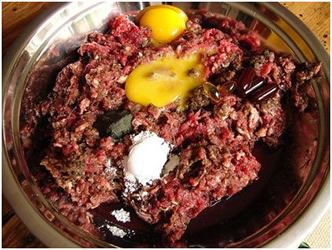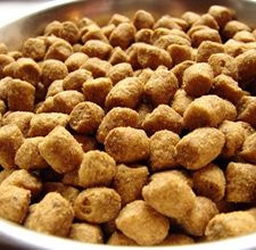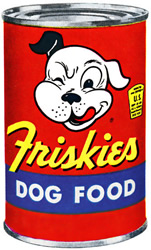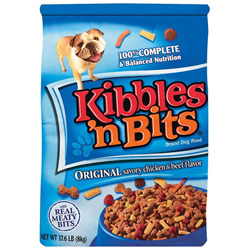Dog Diet
What you feed your dog and how you feed it is key to your dog’s health. Having a balanced dog diet is critical in a dog’s wellness so it is not something to be taken lightly. A good dog diet helps fight disease, improves skin condition, reduces allergies and helps your dog grow better overall. Yet every dog has different nutritional needs and these needs vary over the course of his life. Spend time to research about dog diet to ensure your dog is receives all the nutrients he needs.
As you have probably realized, there are many types of dog diets. You can find kibble mix and canned dog food in supermarkets and there are home-prepared meals that include everything from raw meat, bones, vegetables and fruits. Within commercial dog food, you can choose from so-called life stage diet, weight loss diet, low protein diet and diets rich in certain supplements. For home-prepared food, you can create a dog diet using only raw meat or using a mixture of raw meat, bones, vegetables, and animal organs. With all these options available, what is most suitable for your dog?
To make the right choice, it's important for you to know your dog's nutritional needs. Fortunately for you, there are many experts who can tell you what your dog needs at every stage of his life. Ask for dog diet advice from your dog breeder, veterinarian, animal shelter or rescue center. These are people who can give you a lot of information about what your dog has been eating and how to continue feeding him a healthy dog diet. But as always, keep in mind that no one source will give you all the information you need, so do a little research on your own by at least reading the information I have written on this page.
Home-Prepared or Commercial Dog Food?
First, let’s decide whether to use home-prepared or commercial dog food. Here, I am loosely defining everything you can buy commercially packaged in supermarkets as commercial dog food. These commercial dog foods are further split into kibble, canned, dehydrated and frozen (I will explain the pros can cons of each later). Home-prepared food, on the other hand, usually means things you cannot buy in a branded package. It can be as simple as feeding raw meat or sophisticated as mixtures of meat, veggies and organs.
Your dog’s nutritional requirement is not constant. It is something that changes over the course of his life due to growth, activity level and stage in life. Most puppies grow to their full size in one year, so they require 2-3 times more energy intake than adult dogs and require extra protein and fats in their dog diet to help them grow into strong, healthy adults. However, this is only during the first year of a puppy's life. If you continue to feed a high-protein and high-fat dog diet even after he has matured, it can quickly lead to obesity and other health problems. With so many things to care about, a first time dog owner may find it hard to calculate the perfect balance of nutrients for his dog at every point of his life.
As such, I'd recommend first time dog owners to go for dog diets based on commercial dog food. Reason being is that it is extremely difficult for you to create the right balance of nutrients for your dog at every point of his dog's life. If it is done incorrectly, your dog can suffer malnutrition problems. Additionally, malnutrition for a puppy at an early age will severely hinder physical and mental development.
There is a line of commercial dog food, known as life stage dog food, that is tailored to meet the different nutritional needs as your dog ages. It is carefully formulated by veterinarian nutritionists to provide the optimal nutrition during every stage of your dog's development. Each life stage brand is typically divided by dog size (small, medium and large breed) and life stage (puppy, adult, senior). As a dog owner, you responsibility will be to correctly label your dog size and stage in life to provide your dog a healthy dog diet.
 vs
vs 
 vs
vs 
As you will notice from the feeding instructions, feeding frequency also changes throughout a dog’s life. Puppies under 8 weeks old should be fed 3 to 4 times a day. Dogs older than 8 weeks old should be fed twice a day; once in the morning and once at night.
While I recommend commercial dog food for first time dog owners, I don't mean home-prepared dog diets are inferior to commercial dog food. With extensive research in dog nutrition, a caring dog owner can provide a healthier diet by using home-prepared dog diet. There are many kinds of home-prepared dog diets you can read about on the internet. Some believe in home cooked food made from a mixture of cooked meats and vegetables. Others believe in raw diet, which is further divided into Prey Model and Biologically Appropriate Raw Food (BARF). You can learn more about the benefits of feeding your dog raw food here.
Canned dog food or Dry Dog Food?
If it was up to your dog, he would prefer the canned food dog diet. But as we all know, what taste good may not always be what’s best for you. Whether canned dog food is healthier is a heavily debated topic. Some believe dogs are attracted to it; therefore it must not be as healthy, while others say canned dog food is highly concentrated and gives your dog a fuller meal with less of the filler ingredients found in dry dog food.
 vs
vs 
 vs
vs 
The truth is canned dog food and dry dog foods are probably equally nutritious and the heavy debate between the two is nothing but marketing campaigns by companies on both sides. Dry dog food, however, does have certain advantages over canned dog food. Dry dog food is almost always cheaper and they do not spoil if left out. And most importantly, dogs on kibble dog diets have cleaner teeth because the crunching action required to chew dry dog food promotes jaw muscle development and acts as a toothbrush in scrapping against the teeth, helping to reduce buildup of plague and tartar.
Switching between different dog diet
All dog owners should be aware switching between dog diet require time. You should never switch from one diet to another without a good reason. And it must be done gradually for your dog to be accustomed to the new one. Consult with your veterinarian if you are considering switching diet for your dog.
Poisonous Foods for Dogs
All dog owners should familiarize themselves with this list of poisonous food for dogs. These foods are dangerous for dogs and should never be used in a dog diet. Some of these items may come as a surprise to you because they are perfectly edible for humans. But dogs are not the same as us and they have different digestive systems and chemical processes that keep their bodies in check. Common dangerous foods for dogs include opinion, garlic, grapes and raisons.
Food to Avoid |
Consequences |
|---|---|
Avocado |
Vomiting and diarrhea |
Bones (cooked) |
Can splitter and cause obstruction in digestive system |
Chocolate, Caffeine |
Toxic to the heart and nervous systems. Tremors, seizures, vomiting, diarrhea, hyperthermia, coma |
Garlic |
Kidney damage and hemolytic anemia |
Grapes |
Damage to kidneys. Vomiting and diarrhea |
Macadamia nuts |
Affects digestive and nervous system. Vomiting, join swelling |
Milk |
Diarrhea |
Mushrooms |
Wild mushrooms may be toxic |
Onions |
Kidney damage and hemolytic anemia |
Xylitol (found in chewing gum) |
Hypoglycemia (low blood sugar). Collapse and seizures |
Yeast dough |
Can expand and produce gas in digestive system, causing pain and possible rupture of intestines |
The price of a poor dog diet - Obesity and Malnutrition
Without a balanced diet, your dog can suffer from skin allergies, malnutrition, coat problems and obesity. Nutrition related problems can affect any dogs, no matter the size or breed. Malnutrition at a young age will lead to maldevelopment of bones and muscles and will make the dog susceptible to hip dysplasia and elbow dysplasia later in life.
Nowadays, it is not malnutrition but obesity that is the most significant nutrition-related problem. About 40% of dogs are believed to be overweight. Obese dogs suffer from chronic pain, liver diseases, joint problems, arthritis and heart problems. They are likely to suffer from mobility problems and have a hard time catching their breath during exercises. As a dog owner, it is your responsibility to prevent this by feeding your dog the correct balance of food, limiting treats and providing plenty of exercise opportunities.
If your dog is gaining weight, decrease the amount of food a little and limit the amount of treats you give your dog. Monitor your dog's weight by regularly checking his ribs and waistline. You should be able to feel your dog's ribs but not clearly able to see it. If you can barely feel his ribs, he may be overweight. If you can clearly see his ribs, he may be too skinny. When viewed from above, your dog should have a nice curved waistline. If you see a sausage shape instead, it may be a sign of obesity.
It's important you monitor your dog's body shape to make sure he is receiving the correct balance of nutrients in his dog diet. Sudden weight gain or loss may be a signal of deeper medical problems and should be pointed out to the vet as soon as possible.
What makes a healthy dog diet?
The building blocks of a healthy dog diet is similar to ours. There needs to be protein, fats, carbohydrates, fiber, vitamins, minerals and water. However, the proportion of each varies widely from human needs.
Protein is the essential part of dog diet, it is used in growing muscles, healing injuries, maintaining healthy coats and most importantly providing essential amino acids required for bodily function. Like humans, the essential amino acids must come from food, which is why having a nutritious dog diet is so important. Lean meat and eggs are the best sources to provide all the essential amino acids a dog needs.
Fat also plays an important role in a dog diet. Fat contains vitamins critical to a dog's health, provides the primary energy source, keeps the coat shiny, and strengthens a dog's paws and nose against cracking. Fats are made out of fatty acids and different kinds of fatty acids are needed for different purposes. All fatty acids can be synthesized in a dog's body with the exception of omega-6, which he must get from muscle meat or vegetable oil. The commonly marketed omega-3 is also useful in a dog diet to reduce arthritis symptoms but it must be in the correct 1:5 portion to omega-6 to be most effective.
